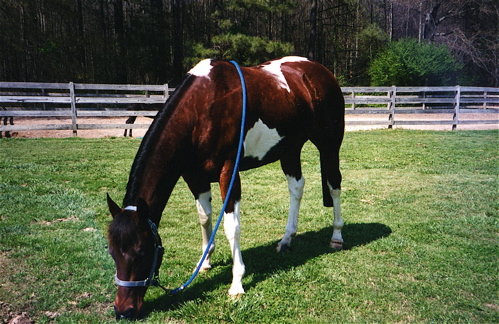-
Broken Legs can not mend-but broken hearts will
 A most somber day, yesterday I had the saddest situation, of having to put my horse and (best friend) down for her final resting place. A broken leg can not be mended, but I hope in time that broken hearts do mend.
A most somber day, yesterday I had the saddest situation, of having to put my horse and (best friend) down for her final resting place. A broken leg can not be mended, but I hope in time that broken hearts do mend.At 23 years of age, she never acted or looked like her years might have told. With personality plus, Sweets was the best mare in the world! She was the stables’ guest horse when someone needed a mount for a friend to ride. She would lead, follow, go through water, fast, slow… whatever you wanted. She could be a baby-sitter or give you an exhilarating ride to raise adrenaline.
For 17 years we had a most special bond, I could walk in the stables and not even say a word… but she knew I was there and would call for me. I’m so very sad, and today I’m scheduled to work half-day at the stables. It will be eery and uncomfortable-walking by her empty stall. There are others I cared for and looked after, Woody the big warm blood, who looks older than his 26 years due to cushing’s disease. And Aqui, the abandoned thoroughbred, who the owner let stay (in a stall) to live out his life.
I’m also the “bird lady” at the stables, and make the hummingbird nectar, clean, and fill the feeders every few days, as well as fill the other window bird feeders on the break room windows. The cats… always sneaking them wet food against the owner’s wishes. They’re supposed to be mousers. Now it feels like my tie to the stables has been severed, but who will take care of all this stuff now? In a few hours I’ll head over and hope for the best…no mental breakdown.
Rest in Peace Sweets 🙁
-
new wave kind of tube bird feeder
 A substantial sized feeder is good… because you simply don’t have to fill them as often. In general, hopper feeders tend to be on the larger size, while tube bird feeders usually hold less seed. This is okay if you don’t have much bird traffic, but right now it seems everyone is fattening up for fall and the yearly migration to southern climates.
A substantial sized feeder is good… because you simply don’t have to fill them as often. In general, hopper feeders tend to be on the larger size, while tube bird feeders usually hold less seed. This is okay if you don’t have much bird traffic, but right now it seems everyone is fattening up for fall and the yearly migration to southern climates.This tube bird feeder is way cool, just the way it looks is pretty darn groovy in itself. I like it because it holds four pounds of seed, and is hand crafted i the USA. Super quality means it will be around for many seasons, and it’s made in two styles; for black oil sunflower or thistle seed. When the perches are all full… it’s really a pretty impressive site to behold.
Finches, Chickadees, Titmice, Nuthatches, and other small songbirds can be seen at a tube bird feeder. This past summer, we were lucky enough to see a few Indigo Buntings at the tube bird feeder in our yard.
As always, a fresh water source, such as a bird bath will always entice more birds than any feeder itself, especially with the severe drought in the Southeast. You can help migratory birds by keeping feeders full and fresh, offering suet and fruit, and a fresh water source in your yard. Something as simple as a large plant saucer filled with water can serve as a birdbath and oasis for many feathered friends!
-
it’s a busy time of year for finch feeders
 With the fall migration under way for many birds, Goldfinches are one of the few species who will actually stay put… especially if you have finch feeders in your yard. Although their vibrant yellow plumage will soon begin to fade and wither with their second molt of the season, these sweet songbirds are full-time residents in most of North America.
With the fall migration under way for many birds, Goldfinches are one of the few species who will actually stay put… especially if you have finch feeders in your yard. Although their vibrant yellow plumage will soon begin to fade and wither with their second molt of the season, these sweet songbirds are full-time residents in most of North America.Aside from being one of the few who experience two molts in the same season, they are also one of the latest breeders, raising nestlings in late summer through early fall. Because of this, you’ll find finch feeders busy with activity this time of year. Babies are fed thistle (or nyjer seed) almost exclusively.
Because of hot, humid weather, seed tends to spoil rapidly, so it’s best to change and clean feeders frequently. If finch feeders are not being emptied quick enough by the birds, don’t fill them all the way. This three-tube finch feeder’s innovative design distributes seed more evenly, so it’s less likely to spoil.
Just because that yellow plumage disappears, your finches won’t! Continue to fill your finch feeders throughout the year, and offer a fresh water source for these and other birds. Creating a wildlife friendly habitat will keep finches around the whole year.
